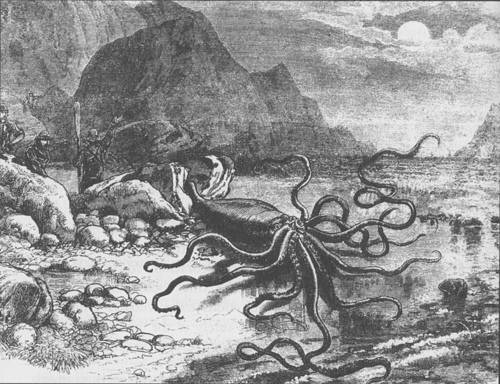How long is the answer to this question?
Ten letters.
How long is the answer to this question?
Ten letters.
One meets with curious things in the old church registers of England. The subjoined, in the Record Office of Winchester Cathedral, dated 1182, is certainly unique. It is a bill for work done: —
To soldering and repairing St. Joseph, 0 l. 8 d.
To cleaning and ornamenting the Holy Ghost, 0 l. 6 d.
To repairing the Virgin Mary and cleaning the child, 4 l. 8 d.
To screwing a nose on the Devil, and putting in the hair on his head, and placing a new joint in his tail, 5 l. 6 d.
— Frank H. Stauffer, The Queer, the Quaint and the Quizzical (1882)

On Sept. 24, 1877, a giant squid was beached alive at Trinity Bay, Newfoundland. At 39.5 feet long, the “nearly perfect specimen” still ranks as one of the largest ever seen.
Ruth Sprague, Daughter of Gibson and Elizabeth Sprague.
Died June 11, 1846, aged 9 years, 4 months, and 3 days.
She was stolen from the grave by Roderick R. Clow, dissected
at Dr. P.M. Armstrong’s office, in Hoosick, N. Y., from which
place her mutilated remains were obtained and deposited here.
Her body dissected by fiendish man,
Her bones anatomized,
Her soul, we trust, has risen to God,
Where few physicians rise.
— Epitaph, Hoosick Falls, N.Y.

“When I play with my cat, who knows whether she is not amusing herself with me more than I with her?” — Montaigne
102 + 112 + 122 = 132 + 142
In the year 1664, on the 5th of December, a boat on the Menai, crossing that strait, with eighty-one passengers, was upset, and only one passenger, named Hugh Williams, was saved. On the same day, in the year 1785, was upset another boat, containing about sixty persons, and every soul perished, with the exception of one, whose name also was Hugh Williams. And on the 5th of August, 1820, a third boat met the same disaster; but the passengers of this were no more than twenty-five, and, singular to relate, the whole perished with the exception of one, whose name was Hugh Williams.
— Bristol Mercury, cited in The Lives and Portraits of Curious and Odd Characters, 1852

3,400 workers built the Empire State Building.
Five died.
gargalesis
n. forceful tickling
Noël Coward was never one for simple congratulations. He sent this telegram to actress Gertrude Lawrence on her debut:
A WARM HAND ON YOUR OPENING
He sent another when she married Richard Aldrich:
DEAR MRS. A HOORAY HOORAY
AT LAST YOU ARE DEFLOWERED
ON THIS AS EVERY OTHER DAY
I LOVE YOU – NOEL COWARD